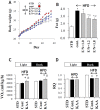Ketogenic essential amino acids modulate lipid synthetic pathways and prevent hepatic steatosis in mice
- PMID: 20706589
- PMCID: PMC2919399
- DOI: 10.1371/journal.pone.0012057
Ketogenic essential amino acids modulate lipid synthetic pathways and prevent hepatic steatosis in mice
Abstract
Background: Although dietary ketogenic essential amino acid (KAA) content modifies accumulation of hepatic lipids, the molecular interactions between KAAs and lipid metabolism are yet to be fully elucidated.
Methodology/principal findings: We designed a diet with a high ratio (E/N) of essential amino acids (EAAs) to non-EAAs by partially replacing dietary protein with 5 major free KAAs (Leu, Ile, Val, Lys and Thr) without altering carbohydrate and fat content. This high-KAA diet was assessed for its preventive effects on diet-induced hepatic steatosis and whole-animal insulin resistance. C57B6 mice were fed with a high-fat diet, and hyperinsulinemic ob/ob mice were fed with a high-fat or high-sucrose diet. The high-KAA diet improved hepatic steatosis with decreased de novo lipogenesis (DNL) fluxes as well as reduced expressions of lipogenic genes. In C57B6 mice, the high-KAA diet lowered postprandial insulin secretion and improved glucose tolerance, in association with restored expression of muscle insulin signaling proteins repressed by the high-fat diet. Lipotoxic metabolites and their synthetic fluxes were also evaluated with reference to insulin resistance. The high-KAA diet lowered muscle and liver ceramides, both by reducing dietary lipid incorporation into muscular ceramides and preventing incorporation of DNL-derived fatty acids into hepatic ceramides.
Conclusion: Our results indicate that dietary KAA intake improves hepatic steatosis and insulin resistance by modulating lipid synthetic pathways.
Conflict of interest statement
Figures








Similar articles
-
Dietary lipid-dependent regulation of de novo lipogenesis and lipid partitioning by ketogenic essential amino acids in mice.Nutr Diabetes. 2011 Mar 28;1(3):e5. doi: 10.1038/nutd.2011.1. Nutr Diabetes. 2011. PMID: 23154504 Free PMC article.
-
The ketogenic diet prevents steatosis and insulin resistance by reducing lipogenesis, diacylglycerol accumulation and protein kinase C activity in male rat liver.J Physiol. 2022 Sep;600(18):4137-4151. doi: 10.1113/JP283552. Epub 2022 Sep 4. J Physiol. 2022. PMID: 35974660
-
Ketogenic essential amino acids replacement diet ameliorated hepatosteatosis with altering autophagy-associated molecules.Biochim Biophys Acta. 2013 Oct;1832(10):1605-12. doi: 10.1016/j.bbadis.2013.05.003. Epub 2013 May 11. Biochim Biophys Acta. 2013. PMID: 23669346
-
Hepatic lipid accumulation: cause and consequence of dysregulated glucoregulatory hormones.J Endocrinol. 2017 Jul;234(1):R1-R21. doi: 10.1530/JOE-16-0513. Epub 2017 Apr 20. J Endocrinol. 2017. PMID: 28428362 Review.
-
The Influence of Physical Exercise, Ketogenic Diet, and Time-Restricted Eating on De Novo Lipogenesis: A Narrative Review.Nutrients. 2025 Feb 13;17(4):663. doi: 10.3390/nu17040663. Nutrients. 2025. PMID: 40004991 Free PMC article. Review.
Cited by
-
Lysosomal Acid Lipase as a Molecular Target of the Very Low Carbohydrate Ketogenic Diet in Morbidly Obese Patients: The Potential Effects on Liver Steatosis and Cardiovascular Risk Factors.J Clin Med. 2019 May 7;8(5):621. doi: 10.3390/jcm8050621. J Clin Med. 2019. PMID: 31067824 Free PMC article.
-
Branched-chain amino acids, mitochondrial biogenesis, and healthspan: an evolutionary perspective.Aging (Albany NY). 2011 May;3(5):464-78. doi: 10.18632/aging.100322. Aging (Albany NY). 2011. PMID: 21566257 Free PMC article. Review.
-
Characteristic metabolism of free amino acids in cetacean plasma: cluster analysis and comparison with mice.PLoS One. 2010 Nov 2;5(11):e13808. doi: 10.1371/journal.pone.0013808. PLoS One. 2010. PMID: 21072195 Free PMC article.
-
Rational design of ¹³C-labeling experiments for metabolic flux analysis in mammalian cells.BMC Syst Biol. 2012 May 16;6:43. doi: 10.1186/1752-0509-6-43. BMC Syst Biol. 2012. PMID: 22591686 Free PMC article.
-
Increased plasma citrulline in mice marks diet-induced obesity and may predict the development of the metabolic syndrome.PLoS One. 2013 May 14;8(5):e63950. doi: 10.1371/journal.pone.0063950. Print 2013. PLoS One. 2013. PMID: 23691124 Free PMC article.
References
-
- Tilg H, Kaser A. Treatment strategies in nonalcoholic fatty liver disease. Nat Clin Pract Gastroenterol Hepatol. 2005;2:148–155. - PubMed
-
- Sanyal AJ. Mechanisms of Disease: pathogenesis of nonalcoholic fatty liver disease. Nat Clin Pract Gastroenterol Hepatol. 2005;2:46–53. - PubMed
-
- Holland WL, Brozinick JT, Wang LP, Hawkins ED, Sargent KM, et al. Inhibition of ceramide synthesis ameliorates glucocorticoid-, saturated-fat-, and obesity-induced insulin resistance. Cell Metab. 2007;5:167–179. - PubMed
-
- Chibalin AV, Leng Y, Vieira E, Krook A, Bjornholm M, et al. Downregulation of diacylglycerol kinase delta contributes to hyperglycemia-induced insulin resistance. Cell. 2008;132:375–386. - PubMed
Publication types
MeSH terms
Substances
Grants and funding
LinkOut - more resources
Full Text Sources
Other Literature Sources
Research Materials
Miscellaneous

